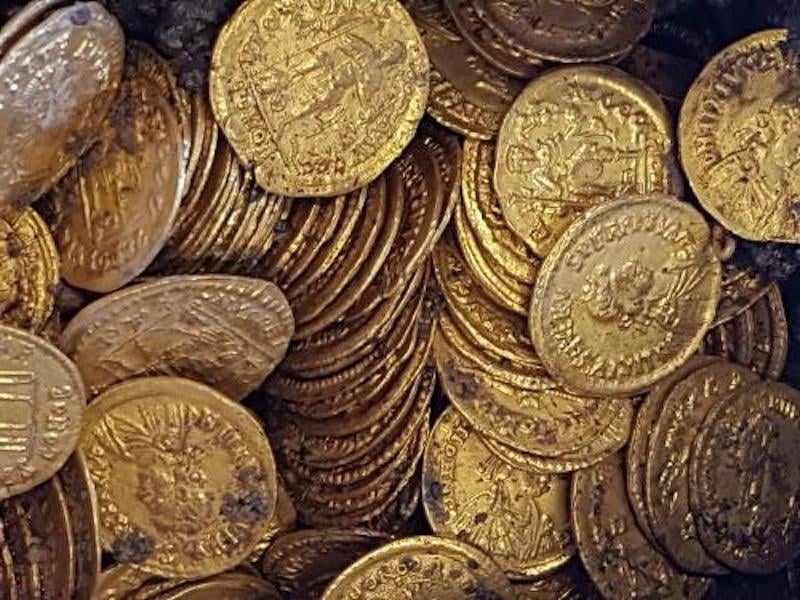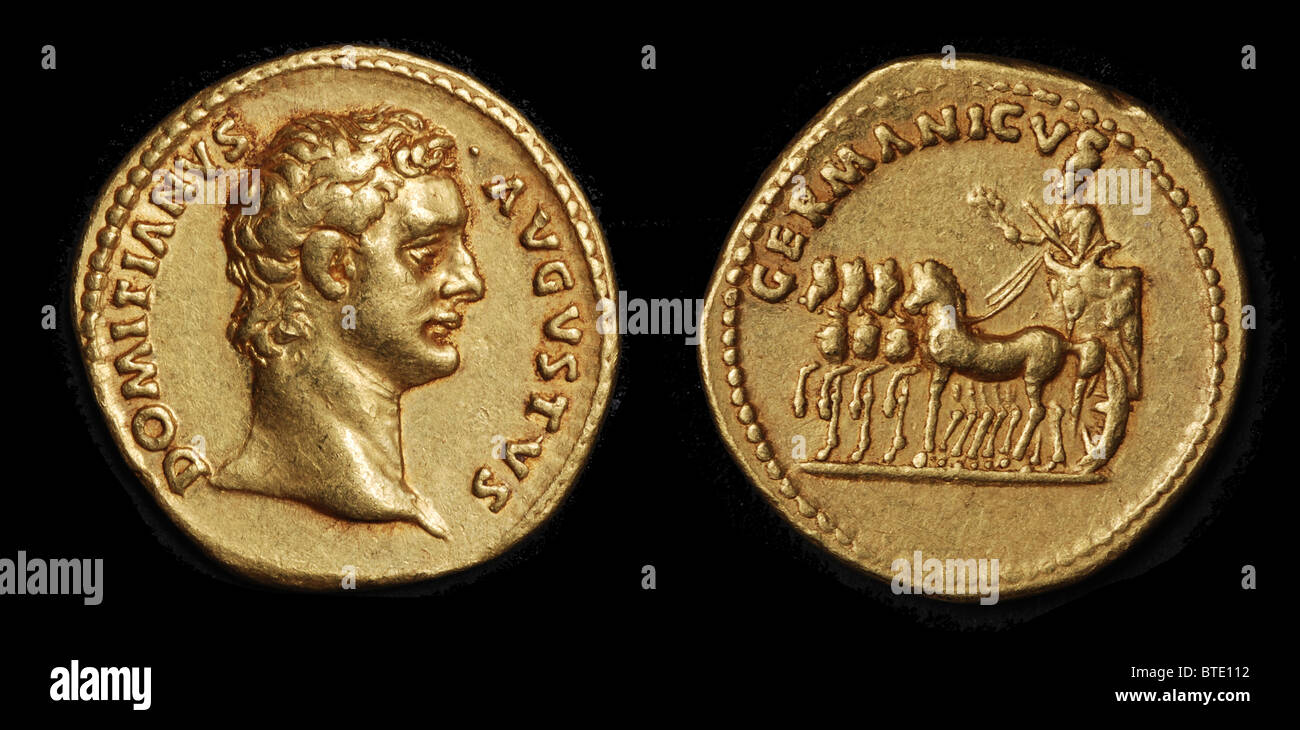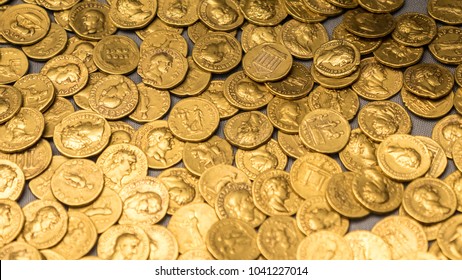Roman Gold Coins
How to collect Roman gold coins? What are the most popular ancient Roman coins? Learn how to start a collection of gold coins from the Roman Republic and Roman Empire.
A preview on ancient Roman coinage
The solidus was reintroduced by Constantine I (r. 306–337) in 312 AD, permanently replacing the aureus as the gold coin of the Roman Empire. The solidus was struck at a rate of 72 to a Roman pound of pure gold, each coin weighing twenty-four Greco-Roman carats, or about 4.5 grams of gold per coin.
Roman ancient coins: the origin of numismatics. Ancient coin collections may have existed since the Roman Empire times. It is known that Augustus would give ancient kings’ coins, as well as foreign coins and tokens as gifts for the Saturnalia festivity. The primary coins of the era were the Gold Aureus, the Silver Denarius, and copper coins of various sizes. Typically Roman coinage had an image of the emperor on the obverse. On the reverse deities like Mars the god of war, or Venus the goddess of love,– would adorn the coins. Roman Empire Gold Coins Roman coinage can be divided into two parts: The Roman Republic of 225-27 BC and The Roman Empire of 27 BC-AD 476. The coins of the Roman Empire began with the first Emperor Augustus on the obverse in 41 BC, with the primary coins being the Silver Denarius and the bronze. Roman Coins: The Aureo The Aureo (1/42 of a Roman pound, about 7.78 g) was the roman gold coin on which the entire imperial series of Roman coins was based. He had as multiple the Quaternario (4 aureo) and as submultiple the quinario (½ aureo). The Denario and the Quinario also remained in use.
The precursors to real Roman coins were made from bronze. Aes rude or rough bronze, aes signatum or signed bronze, and aes grave or heavy bronze were used during the developments of trade and commerce when Romans were looking for a more effective medium of exchange other than barter. Aes grave is considered the first true coins in the history of Roman coinage.

Gold coins in the Roman coinage
The Roman authority often hesitated to strike gold as coins for several reasons. For one, gold was considered a regal metal and was better offered to gods than to be used in daily transactions.
But when Romans indeed mint gold coins, the golden coins were used for administrative payments: to pay for seized booty or pirate treasures, as payment of imperial taxes, and to bribe soldiers and troops. Brass and bronze currency, on the other hand, were used for day-to-day commerce by the common people.
Gold Roman coins were prone to wear especially when handled frequently. For this reason, and because of the potential difficulty in locating and mining gold, the ancient Roman gold coins were often melted down to be recycled.
How to collect ancient Roman gold coins
In general, Roman coins collecting is not a very expensive hobby. The Romans have minted huge numbers of coins in the past and many of these pieces are still left in the present and are available in the coin market.
But the case is different in dealing with ancient Roman gold coins. They are made of precious metal – rarer than other types of collectible coin money from early Rome. Therefore, you should be more cautious when collecting and buying antique gold Roman coins.
1.) Study about collecting Roman ancient gold coins
a. Read books and online articles about gold coins of the late Roman Empire and early Republic of Rome
b. Refer from coin collecting magazines, periodicals, coin price guides, and catalogs to view lists, descriptions, and values of gold coins from antiquity
c. Know how to identify your ancient Roman coins
d. Beware of fake gold coins
2.) Go to a reputable numismatic dealer
a. If you are a beginner, in collecting gold coins, it is advised that you deal with coin sellers personally
b. When you do transactions online, start from dealers recommended by your numismatist friends and other people whom you personally know
c. Take note of customer feedbacks but don’t rely on them because feedbacks could be fabricated.
Types Of Roman Coins
d. Look for dealers who are authorized by numismatic institutions like PCGS or Professional Coin Grading Service
3.) Only consult expert numismatists when in doubt.
Ancient Roman gold coins are valuable so you should only learn about them from the best.
List of common gold Roman coins
Aureus
Aureus was the standard gold coin of the Roman Republic and most parts of the Roman Empire. It was first struck at 1/40 of the Roman pound and was gradually reduced at later time.

Initially the name aureus (plural aurei) was only to describe the type of metal used on the coin, from the Latin word aurum which means “golden”. Later, the term aureus has become a noun representing denomination.
The gold Roman coin aureus was first introduced as emergency money during the Second Punic War but only for a few years and at very limited mintage. At around 82 BC, Roman general and politician Sulla struck golden coins but not as regular currency. Aurei were first produced in volumes during the time of Julius Caesar to pay the Roman legions during wars.
Light aureus

A great decline of Rome’s wealth occurred around 3rd century AD and so there was the need to reduce the weight of the aureus.
The weight reduction was most obvious under the rule of the Roman Emperors Publius Licinius Valerianus (253-260) and Publius Licinius Egnatius Gallienus (260-268).
It is also believed that the rise in the value of gold as base metal pushed the decrease of weight for gold coins. Still, the gold coin money was always made from pure gold unlike silver which was gradually debased (not composed of pure silver metal).
Quinarius
The quinarius was also referred to as quinarius aureus. It was lighter and with a value half of the aureus.
This gold coin was not officially part of the Roman Empire currency but was occasionally minted as ceremonial coins.
Due to some inconsistencies in minting the quinarius, there came a difficulty in determining the difference between a quinarius and a light aureus.
In addition, a quarter aureus was also minted rarely, purely for ceremonial purposes.
Solidus
Rare Roman Coins
The aureus was replaced by solidus around 309 AD under the authority of Constantine the Great.
Although solidus became the standard gold currency by then, the aureus was still occasionally used as ceremonial coins. In 324, aureus was completely phased out in the ancient Roman currency.
The half of solidus was the semissis, gold coins of the later Roman Empire minted mainly for ceremonial uses.
It was produced in volumes and became part of the Byzantine Empire coinage at the beginning of the 6th century.
The aureus (pl.aurei, 'golden', used as a noun) was a gold coin of ancient Rome originally valued at 25 pure silver denarii. The aureus was regularly issued from the 1st century BC to the beginning of the 4th century AD, when it was replaced by the solidus. The aureus was about the same size as the denarius, but heavier due to the higher density of gold (as opposed to that of silver).
Before the time of Julius Caesar the aureus was struck infrequently, probably because gold was seen as a mark of un-Roman luxury.[citation needed] Caesar struck the coin more often, and standardized the weight at of a Roman pound (about 8 grams). Augustus (r. 29 BC – 14 AD) tariffed the value of the sestertius as of an aureus.
The mass of the aureus was decreased to of a pound (7.3 g) during the reign of Nero (r. 54–68). At about the same time the purity of the silver coinage was also slightly decreased.
After the reign of Marcus Aurelius (r. 161–180) the production of aurei decreased, and the weight fell to of a pound (6.5 g) by the time of Caracalla (r. 211–217). During the 3rd century, gold pieces were introduced in a variety of fractions and multiples, making it hard to determine the intended denomination of a gold coin.[1]
The solidus was first introduced by Diocletian (r. 284–305) around 301 AD, struck at 60 to the Roman pound of pure gold (and thus weighing about 5.5 g each) and with an initial value equal to 1,000 denarii. However, Diocletian's solidus was struck only in small quantities, and thus had only minimal economic effect.
The solidus was reintroduced by Constantine I (r. 306–337) in 312 AD, permanently replacing the aureus as the gold coin of the Roman Empire. The solidus was struck at a rate of 72 to a Roman pound of pure gold, each coin weighing twenty-four Greco-Roman carats, or about 4.5 grams of gold per coin. By this time, the solidus was worth 275,000 of the increasingly debased denarii.
However, regardless of the size or weight of the aureus, the coin's purity was little affected. Analysis of the Roman aureus shows the purity level usually to have been near to 24 karat gold, so in excess of 99% pure.
| Name | Gold content | Julius Caesar Aureus |
|---|---|---|
| Julius Caesar Aureus | 8.18 grams | 1.000 |
| Nero Aureus | 7.27 grams | 0.889 |
| Caracalla Aureus | 6.55 grams | 0.800 |
| Diocletian Aureus | 5.45 grams | 0.667 |
| Constantine Solidus | 4.55 grams | 0.556 |
| British Sovereign | 7.32 grams | 0.895 |
| USA Eagle 1837–1933 | 15.05 grams | 1.839 |
| USA Gold Dollar 1849–1889 | 1.51 grams | 0.184 |
| USA Gold Eagle 1986–present | 31.10 grams | 3.802 |
Due to runaway inflation caused by the Roman government's issuing base-metal coinage but refusing to accept anything other than silver or gold for tax payments, the value of the gold aureus in relation to the denarius grew drastically. Inflation was also affected by the systematic debasement of the silver denarius, which by the mid-3rd century had practically no silver left in it.
In 301, one gold aureus was worth 833⅓ denarii; by 324, the same aureus was worth 4,350 denarii. In 337, after Constantine converted to the solidus, one solidus was worth 275,000 denarii and finally, by 356, one solidus was worth 4,600,000 denarii.
Today, the aureus is highly sought after by collectors because of its purity and value, as well its historical interest. An aureus is usually much more expensive than a denarius issued by the same emperor. For instance, in one auction, an aureus of Trajan (r. 98–117) sold for $15,000, and a silver coin of the same emperor sold for $100. The most expensive aureus ever sold was one issued in 42 BC by Marcus Junius Brutus, the assassin of Gaius Julius Caesar, which had a price realized of $3.5 million in November 2020.[2] (There is an example of this coin on permanent display at the British Museum in London.) An aureus, issued by the emperor Alexander Severus (r. 222–235), has a picture of the Colosseum on the reverse, and had a price realized of $920,000 in 2008.[3] An aureus with the face of Allectus was auctioned off in the United Kingdom for £552,000 in June 2019.[4]
See also[edit]
References[edit]
- ^The Imperial Roman Economy. 'Hoarding, Gresham's Law and All That'. www.forumancientcoins.com.
- ^'Goldberg Coins and Collectibles'. Images.goldbergauctions.com. Retrieved 2014-06-07.
- ^'Goldberg Coins and Collectibles'. Images.goldbergauctions.com. Retrieved 2014-06-07.
- ^'Metal detectorist 'ecstatic' after find on farm turns out to be ultra-rare Roman coin fetching £552,000 at auction'. www.msn.com. Retrieved 2019-06-10.
External links[edit]
| Wikimedia Commons has media related to Aureus. |
